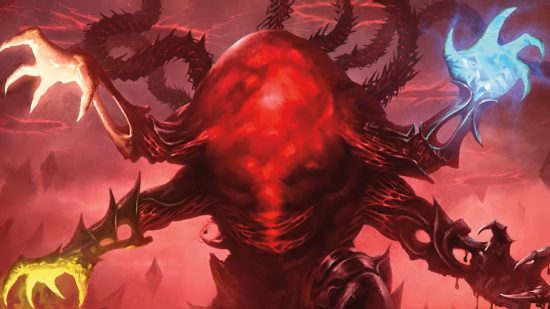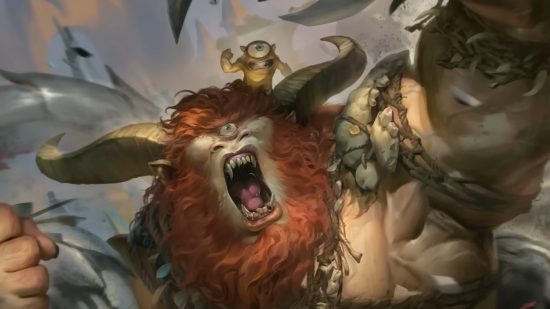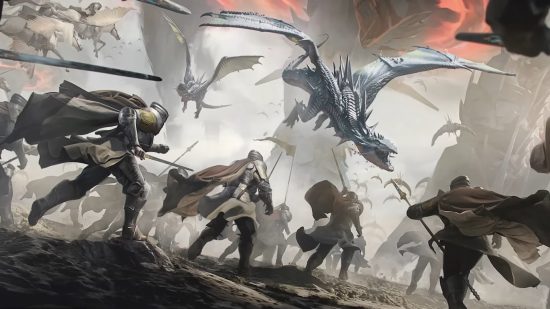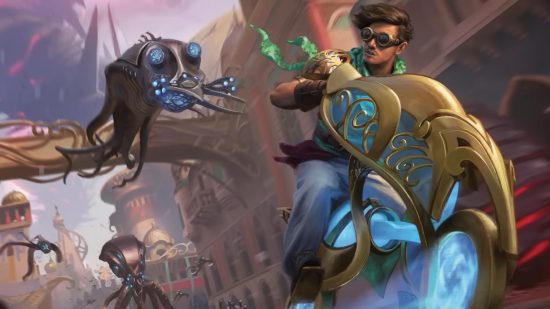We recently asked Magic: The Gathering head designer Mark Rosewater for the scoop on March of the Machine. Here’s what he had to say about working on this set:
Wargamer: You’ve previously called March of the Machine the most ambitious set you’ve ever made. What makes it more ambitious in your mind than sets like War of the Spark and Time Spiral?
Mark Rosewater: I’ve worked on Magic for 28 years, and March of the Machine has a scope larger than anything I’ve ever designed. War of the Spark, for example, made use of (almost) every known Planeswalker, but it was all located on just one plane. March of the Machine makes use of (almost) every known plane in the multiverse. Legendary characters, unique creature types, specific locales – March of the Machine borrows from just about every Magic set we’ve ever made. When we began, I truly didn’t know if we could pull off a conflict this big and far reaching, but I’m proud to say we did, and we made something truly awe-inspiring.
Wargamer: Was it nerve wracking to work on a set that pushed the envelope out to this extent?
Mark Rosewater: One of the reasons I enjoy my job so much is I like a good challenge. I like being presented with something we’ve never done before and then figuring out how to do it. I will admit though that March of the Machine was a daunting project to start. We began by figuring out if we could represent the larger conflict by just showing pieces of it, but soon realised that if we’re making a set about a war across all of the worlds you’ve ever seen, we needed to show them all.
Wargamer: What is your favourite card in the set? Which has the best story behind it?
Mark Rosewater: I really enjoy the team-up legendary creatures. We were trying to demonstrate how desperate things have gotten during the war with the Phyrexians, and we got the idea of pairing together creatures that would never normally work together. The one that probably makes me smile the most is Borborygmos and Fblthp. Obviously, times are bad on Ravnica if these two are teaming up.
Wargamer: Where did the idea for Battles come from? How was it decided that Magic needed an entirely new card type, rather than making them a subtype of something else like enchantments or artifacts?
Mark Rosewater: When we started the design, the core of my vision for the set was I wanted planes to be to March of the Machine what planeswalkers had been to War of the Spark. This was an interplanar conflict, so I wanted us to view the set through that lens.
To do this, I felt it was important that we have a card that represented each plane. I didn’t know whether or not it was going to be a new card type or just a new subtype, but I wanted the set to capture the scope of what was going on, and I wanted each plane to get its time to shine as a whole entity on a card. The design we ended up with for battles was different enough from any other card type, that we felt it warranted being a new card type.
Also, a new card type is allowed to bake rules into the definition of the card type. If we had made Battles a subtype (probably of enchantments) the rules text to define what the card does wouldn’t have fit on the card.
Wargamer: What are the main advances Magic has made since WAR, the last ‘grand finale’ set, that allows you to have these big story moments within a card game?
Mark Rosewater: The second time you do anything, you have all the lessons from the first time you did it. I didn’t really understand the lens War of the Spark needed to be seen through until halfway through the vision design of the set. I spent a lot of time focusing on the “war” part of “Planeswalker war” rather than the “Planeswalker” part.
I started March of the Machine understanding the need for a clear lens, as I said above, and was able to start the design with this clear vision already in mind. War of the Spark also taught me how to think bigger when trying to capture a grandiose storyline. I started War assuming I got three to five planeswalkers and ended up with thirty-six. I approached March of the Machine prepared to push boundaries when needed.
Wargamer: What aspects of March of the Machine do you think are really going to shine for Magic fans?
Mark Rosewater: I think March of the Machine works on two levels. One, it’s just an epic war story. We see all the inhabitants of the multiverse banding together against a great evil. I think we did a good job of both capturing the scariness and threat of the Phyrexians, while also showing how the denizens of the multiverse band together to survive.
Two, this set is a love letter to all the fans of the worlds and characters of Magic. Odds are if we’ve ever visited a world, no matter how briefly, it shows up in this set, and while we couldn’t get every Magic character in it (there are a lot!), we got in as many as we could. We even made a whole bonus sheet of famous legendary creatures so we could fit in a bunch more. Magic is thirty years old this year and we’ve never made something of this scope. It is truly something you must see to appreciate.



